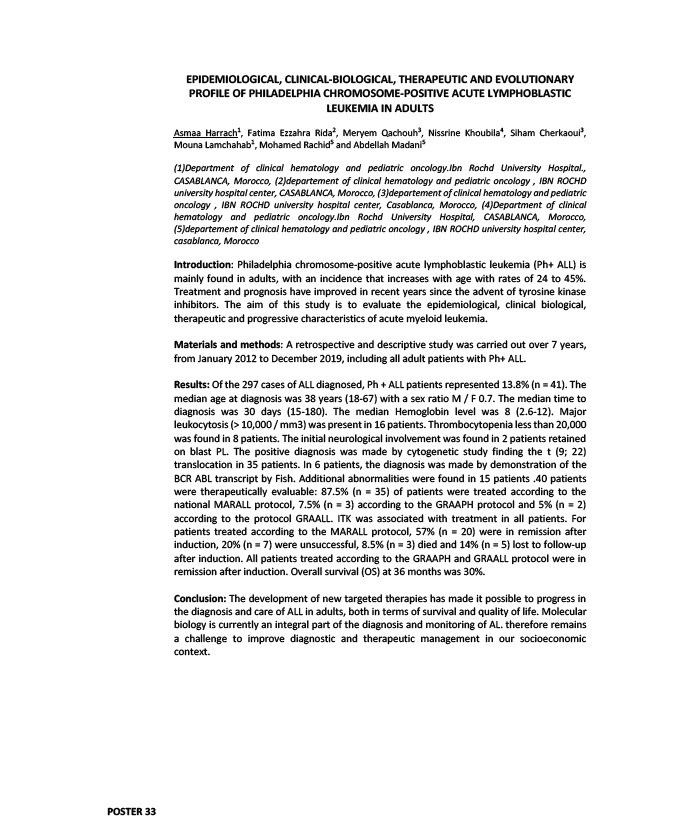
EPIDEMIOLOGICAL, CLINICAL-BIOLOGICAL, THERAPEUTIC AND EVOLUTIONARY
PROFILE OF PHILADELPHIA CHROMOSOME-POSITIVE ACUTE LYMPHOBLASTIC
LEUKEMIA IN ADULTS
Asmaa Harrach1, Fatima Ezzahra Rida2, Meryem Qachouh3, Nissrine Khoubila4, Siham Cherkaoui3,
Mouna Lamchahab1, Mohamed Rachid5 and Abdellah Madani5
(
1)Department of clinical hematology and pediatric oncology.Ibn Rochd University Hospital.,
CASABLANCA, Morocco, (2)departement of clinical hematology and pediatric oncology , IBN ROCHD
university hospital center, CASABLANCA, Morocco, (3)departement of clinical hematology and pediatric
oncology , IBN ROCHD university hospital center, Casablanca, Morocco, (4)Department of clinical
hematology and pediatric oncology.Ibn Rochd University Hospital, CASABLANCA, Morocco,
(5)departement of clinical hematology and pediatric oncology , IBN ROCHD university hospital center,
casablanca, Morocco
I
ntroduction: Philadelphia chromosome-positive acute lymphoblastic leukemia (Ph+ ALL) is
mainly found in adults, with an incidence that increases with age with rates of 24 to 45%.
Treatment and prognosis have improved in recent years since the advent of tyrosine kinase
inhibitors. The aim of this study is to evaluate the epidemiological, clinical biological,
therapeutic and progressive characteristics of acute myeloid leukemia.
Materials and methods: A retrospective and descriptive study was carried out over 7 years,
from January 2012 to December 2019, including all adult patients with Ph+ ALL.
Results: Of the 297 cases of ALL diagnosed, Ph + ALL patients represented 13.8% (n = 41). The
median age at diagnosis was 38 years (18-67) with a sex ratio M / F 0.7. The median time to
diagnosis was 30 days (15-180). The median Hemoglobin level was 8 (2.6-12). Major
leukocytosis (> 10,000 / mm3) was present in 16 patients. Thrombocytopenia less than 20,000
was found in 8 patients. The initial neurological involvement was found in 2 patients retained
on blast PL. The positive diagnosis was made by cytogenetic study finding the t (9; 22)
translocation in 35 patients. In 6 patients, the diagnosis was made by demonstration of the
BCR ABL transcript by Fish. Additional abnormalities were found in 15 patients .40 patients
were therapeutically evaluable: 87.5% (n = 35) of patients were treated according to the
national MARALL protocol, 7.5% (n = 3) according to the GRAAPH protocol and 5% (n = 2)
according to the protocol GRAALL. ITK was associated with treatment in all patients. For
patients treated according to the MARALL protocol, 57% (n = 20) were in remission after
induction, 20% (n = 7) were unsuccessful, 8.5% (n = 3) died and 14% (n = 5) lost to follow-up
after induction. All patients treated according to the GRAAPH and GRAALL protocol were in
remission after induction. Overall survival (OS) at 36 months was 30%.
Conclusion: The development of new targeted therapies has made it possible to progress in
the diagnosis and care of ALL in adults, both in terms of survival and quality of life. Molecular
biology is currently an integral part of the diagnosis and monitoring of AL. therefore remains
a challenge to improve diagnostic and therapeutic management in our socioeconomic
context.
POSTER 33